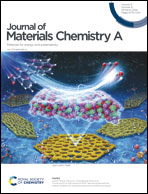Ytterbium–nitrogen co-doped ordered mesoporous TiO2: an innovative hetero-phase photocatalyst for harnessing solar energy in green hydrogen production†‡
Abstract
Defect-induced (Yb,N) double-doped ordered mesoporous titania, denoted as Yb/N-OMT, with a high specific surface area, was successfully synthesized in a reproducible way via the evaporation-induced self-assembly method. These nanostructured mesoporous materials were prepared using Pluronic F127 and Synperonic F108 as structure-directing agents and were respectively denoted as Yb/N-TMF-127 and Yb/N-TMF-108. All the samples were systematically characterized by employing various analytical, spectroscopic, and imaging methods. The well-defined high-quality periodic network of ordered pores was described by combining the results from analytical and imaging techniques such as small-angle XRD, high-resolution TEM, and BET studies. On the other hand, spectroscopic studies including EPR, PL, XPS, and AES suggest that the dopants, viz., ytterbium and nitrogen ions, were uniformly distributed throughout the crystal lattice, thus creating a substantial amount of intrinsic defects, i.e., electrons trapped in oxygen vacancies and/or Ti3+ centres at the surface. Furthermore, the incorporation of Yb3+ into the TiO2 matrix effectively reduces the crystallite size, improves thermal stability, and extends the light absorption to the visible and infrared regions. Indeed, such induced defects in Yb/N-OMT are responsible for the facile charge separation of photogenerated excitons, which in turn enhance photocatalytic hydrogen generation, more than twice as high as commercial P25 TiO2.

- This article is part of the themed collection: Celebrating the scientific accomplishments of RSC Fellows


 Please wait while we load your content...
Please wait while we load your content...